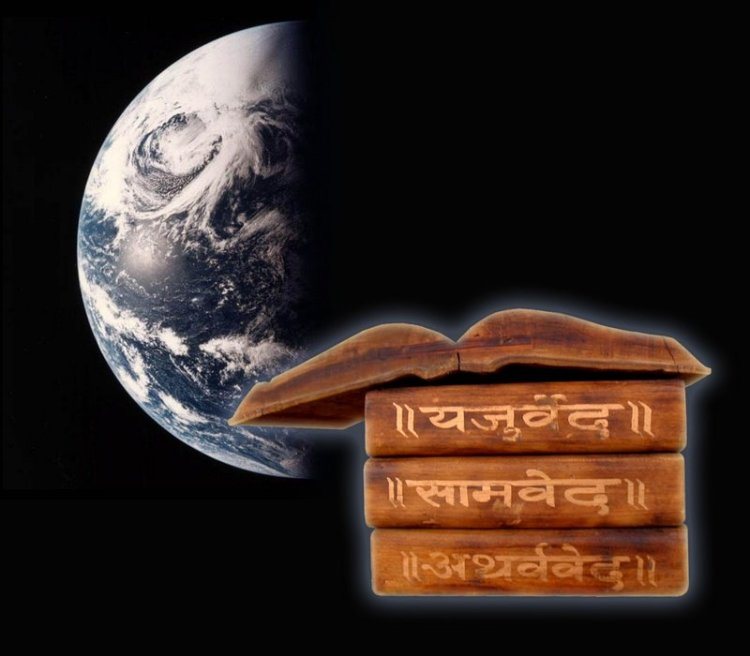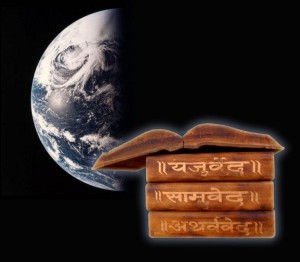
Ancient Persians named composite India where river Sindhu flows as Hindu nation and it’s people as Hindus (because they used the vowel ‘Ha’ instead of ‘Sa’) and the nomenclature ‘India’ is the derivation from Indus, the other name by which river Sindhu was known to the westerners.
Origin of Terms
Puraanas refer to the country of India as Bharatha Khanda, Bharathavarsha or as Jamboo-Dweepa. Swami Vivekananda, the great philosopher, had preferred to call Hindus as Vaidikas, the followers of Vedas or Vedaantists, the followers of Vedaanta. He further said that most of the great religions of the world owe allegiance to certain books which they believe are the words of God, and which are the basis of their religion and according to modern savants of the West, the oldest amongst such books are the Vedas of the Hindus.
Origin of Vedas
As per the belief of Hindus, the Vedas were not the task of a single person or messenger. Most other religions of the world claim their authority as being delivered by a Personal God or a number of personal beings, angels or special messengers of God, unto certain persons; the claim of the Hindu is that the Vedas do not owe their authority to anybody, they are themselves the authority, being eternal-the knowledge of God.
They are never written, never created, they have existed throughout the time; just as creation is infinite and eternal, without beginning and without end, so is the knowledge of God, without beginning and without end. And this knowledge is what is meant by Vedas (Vid= to know). The mass of knowledge called the Vedaanta was discovered by personages called Rishis, seers of thought, not that the thought was their own.
According to traditions when the Supreme Lord created this material world, His transcendental energy pervaded every corner of it. This spiritual energy was the pure vibration, Shabda-Brahma, in which Supreme Himself can be found. This pure sound vibration is manifested as the ‘OM’ Mantra, the resting place of everything, or in other words, all potencies are invested within this Holy vibration.
Lord Krishna in Bhagavad Gita Says:
“Pitam-asya jagato mataa dhaata pitaa-mahah l
Vedam pavetram Omkaara rig saama yajur-eva vha l l
Meaning:
I am the father of this world, the mother, the supporter, the person to be revered, the one to be known, the holy one, the sacred syllable ‘OM’ as also the Rig, Saama and Yajur (Vedas)
How Vedas were first compiled into written form is explained thus: Lord Vishnu taught the Vedic knowledge to Brahma who in turn taught this to other great sages and mystics (who had observed the life long vow of celibacy in order to retain the Vedas in their memory) who become manifest, including Naarada Muni who taught it to others. This is where the oral traditions began and for thousands of years Vedas were carefully handed down this way till sage Vedavyaasa, at the end of Dwaapara Yuga, divided it into four parts and put them in written form so that more materialistically minded people of Kaliyuga, the present age, could more easily understand them.
The four Vedas are:
- Rig-Veda
- Yajur-Veda
- Saama-Veda
- Atharvana-Veda
Puranas
Apart from that there is a fifth form where the historical facts and authentic stories mentioned in Puraanas are called the fifth Veda.
Shruti
Vedas, Vedaanta Suutras and Brahmanas, Aranyakas and Upanishads are all considered to be ‘Shruti’, the original revealed knowledge.
Smriti
Other parts of Vedic literature consisting of Mahabhaaratha, Bhagavad Gita, Ramaayana and other Puraanas are called ‘Smriti’.
Arya
A person who follows the path as directed by Shruti and Smriti is called Aarya.
Few of the other Vedic literatures are:
- Ayaurveda- Original Science of holistic medicine as taught by Lord Dhanvantri.
- Dhanurveda- Military Science as taught by Maharshi Bhrigu.
- Artha Shaastra- Science of Government –Politics.
- Gandharva Veda- an art of music, dance, drama etc.,
- Stapatya Veda- Science of Architecture. Ratha (Chariot) Shilpa, Vimaana (Aeroplance) Shilpa, Nauka (Ship) Shilpa, Durga (Fort) shilpa, Nagara (Town) Shilpa, Murthy (Sculpture) Shilpa, etc.,
- Manu Smriti- Vedic Law Book-based on Dharma-Suutra of the Maanavaas.
- And Paaka Shaastra, Kaama Shaastra etc.
Sanskrit and Vedic Language:
Sanskrit is the ancient sacred and literary form of language of India as distinguished from the earlier Vedic. It is of great interest to linguists because of the stimulus which the introduction of Sanskrit to Western Scholarship gave to the development of modern linguistic science (H.A. Gleason Jr.)
‘Vedas’, the most ancient documents of Indian thought, culture and sacred lore pave the path of final release or moksha through righteousness, and as such, their message and teachings cut across all the possible boundaries of country, creed and age. They are universal in their meaning and appeal, and belong to the whole humanity and are for all ages.
The great German thinker Max Mueller very emphatically says, “I maintain that for a study of man, there is nothing in the world equal in importance with the ‘Veda’. I maintain that to every body who earns for himself, for his ancestors, for his history or for his intellectual development, a study of Vedic literature is indispensable…. To the present day India acknowledges no higher authority in matter of religion, ceremonials, customs and law than the Veda”. What constitutes Vedic lore, stands alone and apart in it’s splendour like the Pole Star shedding the divine light for the onward progress of entire humanity.
Trinity of Vedas
Though there are four Vedas, traditionally they are spoken as “”Trayi”, the Triple Vidya or the threefold knowledge, because they deal with jnaan, Bhakti and karma and are in prose, verse and songs. The Rigveda underlines the path of Jnaan or knowledge, the Yajurveda that of Karma or Action, and Saamaveda that of Bhakti or Devotion.
Atharvanaveda represents a synthisis of the three. Therefore the Vedas are invariably referred to as the “Triple Eternal Vedas” (Trayam Brahma Sanatana), probably also because the fourth one i.e., the Atharvanaveda is relatively of quite a late orgin.
These four together form the foundations of Indian religious, philosophical and cultural systems and observances. Indian culture and civilization has survived the ruthless ravages of time all these millenniums only because it is based on the rock like foundation of the wisdom of the Vedas.
The One God
The Vedas have categorically declared many times that Reality is one, sages call it by various names; God is one, but it’s dimensions are several. The various Vedic Gods are simply the different manifestation of the same Reality. This so called multiplicity of Gods amply reflects the essential Vedic doctrine, “All path lead to the same goal”. The truth is one, and everyone is seeking it. The individual temperament, time, place, name etc., create the do called differences.
The world is but the manifestation of a part of Him:
What was, what is and shall be, All is OM.
Whatever else is beyond the bound of three fold time
That also is OM
